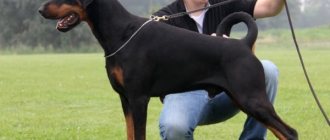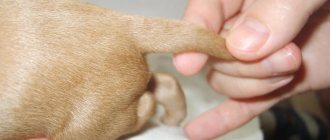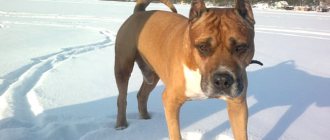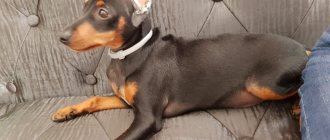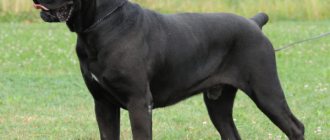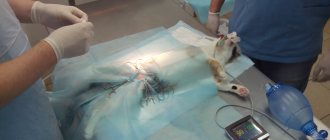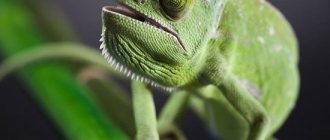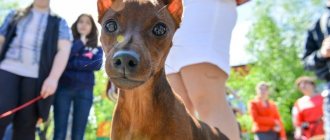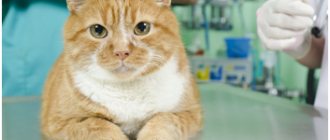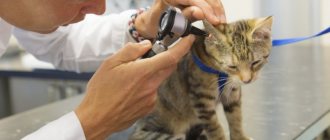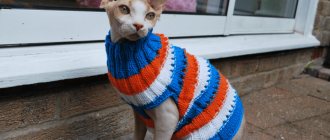Dobermans are graceful, athletic and fearless in appearance.
This is an ideal protector, but despite its formidable appearance, the Doberman is a friendly and peaceful companion for its owner.
He is distinguished by his mental balance, intelligence and intelligence.
The magnificence and elegance of the Doberman are given by cropped candle-shaped ears, set high above the head, and a graceful short tail with a slight bend.
How does the operation take place?
Tail surgery occurs in two ways:
- The first, and least painful method involves removing the organ with surgical scissors within three days of the puppy’s birth. The operation does not require anesthesia and does not require stitches. Ideally carried out by veterinarians, but can also be carried out by breeders at home.
- The second method is to apply a special rubber band (ligature) to the tip of the tail. The ligature does not allow blood access to the tip, and after a few days it falls off on its own.
Here's how ear cropping works. Here, anesthesia is required for the dog, since the procedure itself is quite painful. You cannot feed the animal 12 hours before surgery. The dog is fixed on the operating table after a dose of novocaine or antipsychotic is administered. Sometimes the operation is performed under general anesthesia. The circumcision process itself occurs using a scalpel. After the cupping procedure, the wound is sutured and treated with antibacterial agents. The duration of the operation generally takes from 30 minutes to 1.5 hours.
Rehabilitation period
After docking the tail, monitor the puppy for several hours to avoid bleeding. Kutya heals quite quickly and without complications.
After ear surgery. To prevent the animal from scratching the seams, a special plastic frame is put on it. If the animal feels pain and constantly rushes about and whines, it is prescribed painkillers. Also spend a lot of time on the seams, they need to be constantly processed. For disinfection, use hydrogen peroxide, brilliant green, calendula tincture or streptocide.
The stitches are removed after a couple of weeks, but the rehabilitation period does not end there. If, after removing the stitches, they have healed correctly, ears will still need to be fitted for the owner and dog.
Possible complications
What a docked tail can theoretically affect:
- communication with animals and socialization. Since this organ is the dog’s means of communication, its removal may affect the perception of it by other animals. Relatives are more aggressive towards bob-tailed dogs, as they do not always correctly perceive their behavior and motives;
- increased aggression. It has been statistically proven that docked dogs are more aggressive than their relatives with healthy tails;
- joint problems. Due to improper distribution of the load on the hind limbs, the animal may develop a hernia in the future. Also, removal of the tail is fraught with the development of deformities of the fingers of the hind limbs;
- motor skills. The tail is not only a way of communication, but also an important regulator of the animal’s movements. Due to its absence, some problems with motor skills arise. Ordinary dogs do not skid as much when turning as docked dogs;
- psyche. Research shows that tail removal, even at an early age, is very painful for the puppy and the shock experienced can lead to mental problems in the future.
Ear cropping is fraught with all sorts of infectious diseases. The dog's ears become open to rainwater, dust and dirt, which can lead to serious illnesses. In addition, if the operation was performed by a non-specialist, the animal’s sutures may not heal properly.
Care requirements and conditions for keeping swordtails
Swordtails do not need any special conditions. In fact, maintaining optimal aquarium water parameters is the key to their well-being. However, do not forget that:
1. Swordtails definitely need aeration and filtration, weekly replacement of up to 1/4 of the volume of aquarium water. It is worth noting that these fish do not need a lot of oxygen, and too frequent changes (replacement) of aquarium water are not as beneficial for them as for other types of aquarium fish. Therefore, if you change the water less often, for example, once every 14 days, and not every 7, nothing bad will happen. This rule is appropriate with a stable biobalance and zero nitrogen: NH4, NO2, NO3.
As with any other fish, high concentrations of poisons are unacceptable: ammonia, nitrites and nitrates. Every conscientious aquarist should always have a set of drop tests on hand, at least for nitrate and phosphate. Fortunately, they have now become inexpensive, there are no problems with their assortment and acquisition. For example, we can in good conscience recommend you the cool UHE drop tests that have been tested on ourselves, but they are only sold online. In stores in your city - offline, you can find inexpensive Vladox tests. Friends, watch out for nitrogen compounds, keep them in check and everything will be fine for you and your pets.
It would be useful to use clean water supply for deep water changes and use preparations that neutralize harmful substances. For example, Tetra AquaSafe - it removes chlorine compounds, heavy metals + contains B vitamins, iodine and other aquarium goodies.
2. The aquarium must be covered with a lid, because The fish are nimble and can jump out and die.
3. Like many fish, swordtails feel comfortable among vegetation. It is recommended to use Vallisneria, Echinodorus, Cryptocoryne, Riccia, duckweed and other plants as aquarium plants. Creating thickets of plants imitates the natural habitat of fish.
4. When decorating an aquarium, it is necessary to organize an open space for swimming. Swordtails are excellent swimmers. Swordtails do not need shelter at all.
Cupping
Whether this is necessary is up to you to decide.
Why do this?
- First of all, for beauty, since high protruding ears and a short tail are the distinctive features of the Doberman breed.
- To eliminate vulnerability in combat.
- For medicinal purposes.
At what age?
Ear cropping in puppies is done before the tail. In 5-7 days (bleeding will be less and healing will be faster) or 5-8 weeks.
How to carry out the procedure correctly?
Special clips are used for the selected shape, but not more than 2/5 of the ears. There is no need to feed on this day.
Vet
It is better to use the services of a professional veterinarian. It will be more expensive, but with less trauma for the pet, since the operation will be performed under anesthesia.
Undocked dog with ears and tail and photo
Today, undocked Dobermans are recognized as a full-fledged breed, and are increasingly winning at exhibitions. Germany, England, Holland, Scandinavia and Austria have already introduced a ban on this operation. Below you can see a photo of a Doberman with undocked ears and tail:
Forms
The shape of the ears is created in proportion to the size of the head
It is important that this is done by a specialist. After all, Doberman ears are a source of pride for the owner.
As a result, they should stand like horns.
This process is long and painstaking. We need to be patient. The dog will have to wear a special “crown”, and you will constantly have to glue the ears with adhesive tape, adjusting the shape.
Opinion of Dobermann breeders
With their floppy ears and tails, Dobermans are not your typical elegant breed. The procedure will help give the animal rigor and thoughtfulness. The eared representatives resemble ordinary hunting dogs, so connoisseurs of the breed rarely refuse to intervene.
Breeders remind that the operation must be carried out in a veterinary hospital, otherwise the pet’s appearance will be spoiled and serious damage will be caused to its health. The choice about the future appearance remains with the owner of the Doberman; if it is intended to be a pet and companion, then it is not necessary to follow traditions.
There is a risk that exhibition events in certain countries will become unavailable for the operated animal. There is an opinion that soon the ban on cupping will extend to the territory of Russia.
Care
Caring for a Doberman is not difficult:
- There is no need to comb the fur.
- Daily wiping with a wet towel is enough.
- You can bathe once every six months (frequent bathing weakens the immune system).
- Wash your paws after a walk.
- Systematically clean your ears and eyes with a cotton swab dipped in water.
- Watch your teeth and claws.
How to trim claws?
The length of the claws must be monitored. If they themselves do not grind down enough, then they need to be trimmed. This can be done at the veterinarian or at home using special nail clippers. You only need to cut off the keratinized part without touching the body of the claw to avoid injury. If there is blood, then it is enough to attach several crystals of potassium permanganate to the vessel on paper.
It is important to calm the dog so that the procedure does not cause negative associations in the future. It is enough to cut your nails once every 1-2 months.
Dental care
Doberman's teeth are their calling card. They should be closely monitored because they are susceptible, just like humans, to caries and periodontal disease. Inspection and cleaning must be carried out daily. There are dog toothbrushes and toothpastes for these purposes.
How to brush your dog's teeth with tomato paste?
Many dog owners have noticed the almost magical properties of tomato paste. It is believed that in the fight to keep animal teeth clean, there is no better “folk” method to be found. It has been noticed that with constant use of this culinary ingredient, not only plaque comes off, long-standing stones disappear. The not very pleasant smell from the mouth also disappears without a trace. In addition, natural tomato paste will not harm the dogs’ stomach, even if they swallow it whole. The procedure is perceived quite calmly by four-legged animals. So, how to use the miracle tomato toothpaste to shine your pet's mouth?
- Take a bandage or small piece of gauze and wrap it around your finger.
- Dip in tomato paste.
- Brush your teeth as usual.
Most often, tomato paste is used not for daily cleaning of the jaws, but for the quick and effective removal of tartar. Then it is used after regular brushing with dog paste. In this case, they try to focus on the area between the teeth and gums.
Is it necessary to dock the tail and why?
A similar situation exists with tail docking. Dobermans with a short tail are more common than those with a long tail.
Most of all breeders carry out this procedure with puppies, so it is incredibly difficult to meet long-tailed Dobermans.
There is one catch with this - due to docking, the genetic shape of the tail is not fixed in any way in the standard.
Therefore, it is impossible to determine which tail of an undocked dog is suitable and which is defective. A puppy can be born with a completely different tail - bent, twisted, raised up.
This is another reason why it is better for a Doberman to have this part of the body docked, because you will always be at risk when participating in exhibitions or competitions.
NOTE! The tail must be docked if the dog develops in hunting and fighting activities.
Tail docking is a procedure that also depends on the wishes of the owner, but the shortened appearance of the tail is the most acceptable feature for a Doberman.
Advantages and disadvantages
This aspect of the breed was also the subject of controversy after Germany banned Doberman tail docking.
As usual, two sides emerged, opponents and supporters of this procedure.
Pros of tail docking:
- The dog's injury rate is reduced;
- Pleasant and familiar aesthetic appearance;
- Avoiding disqualification at some shows.
Cons of tail docking:
- It will be more difficult for the dog to socialize among other relatives;
- Expressing emotions with a tail is much easier;
- Participation in international exhibitions is allowed.
General information about the procedure
Many dog breeders consider the procedure for cropping dogs' ears to be a personal whim of the owners. However, according to veterinarians, partial amputation of the ears often prevents the development of various pathologies. The operation is recommended for those dog breeds that are genetically predisposed to ear diseases.
Ear cropping is recommended for representatives of fighting and hunting breeds
What is the procedure for ear cropping in dogs? Under general anesthesia, the veterinarian removes the top of the ear. Most often, half of the ear is subject to amputation, much less often – the third part. The first few days after surgery, the pet needs special care and attention from the owner.
In most cases, the procedure is virtually painless for the animal. It should be noted that the dog’s condition depends on the experience and professionalism of the doctor. You should not trust the life and health of your four-legged friend to an unfamiliar or inexperienced veterinarian.
Ear cropping does not have a reverse “move”. Before deciding to undergo surgery, carefully weigh the pros and cons. Most European countries have long abandoned this procedure; Russian dog breeders have still not reached a consensus.
Optimal timing
So, at what age can a Staffordshire Terrier get ears? The success of the operation depends on the correct timing. The optimal age for a puppy is 8–12 weeks. It is unwise to carry out elective surgery at a later age, as the likelihood of possible complications increases.
The older the dog is at the time of surgery, the longer the postoperative period lasts. Experienced dog breeders also note that puppies tolerate pain much easier and quickly get used to the new ear shape.
Indications
The first reason for carrying out cosmetic surgery to remove part of a dog’s ear is remnants of the past. Cupping was used during the reign of the ancient Egyptian pharaohs. As you know, habits formed over centuries take years or even decades to eradicate.
The second reason is the health of the pet or the prevention of the development of ear pathologies. Amputation is recommended for injuries, ulcers, neoplasms of various origins and necrosis of the auricle. A highly qualified veterinarian should make a diagnosis and suggest cupping as a method of solving the problem.
The third reason is the characteristics of the breed. Ear cropping is recommended for representatives of fighting and hunting breeds, including the Staffordshire Terrier. In the process of fighting with other animals, there is a high risk of injury or rupture of the ear.
Cupping prevents the development of ear diseases in Staffies
Contraindications
Surgical intervention has a number of contraindications. Cupping is contraindicated if there are obvious signs of illness in your pet. Increased body temperature, apathy, lack of appetite and other disturbances in the animal’s behavior are reasons for contacting a veterinarian. First you need to understand your pet’s well-being and only then make a decision about the need for surgery.
Another contraindication is obvious deviations in the physiological or mental development of the puppy.
Predisposition of Doberman Pinschers to Diseases
Starting from an early age, Doberman puppies are characterized by good health and endurance. Meanwhile, this breed is characterized by some hereditary pathologies:
- Wobbler syndrome, accompanied by disorders in the joints and vertebrae - dislocations, displacements;
- hypothyroidism is an abnormality of the thyroid gland;
- panostitis - congenital lameness without traumatic causes;
- dysplasia - pathological changes in tissue in the hip and elbow joint;
- von Willebrand-Jurgens syndrome is a bleeding disorder of blood components.
Some of these diseases are a result of the Doberman's weight putting pressure on his joints.
To maintain health, puppies and adults are recommended to be vaccinated against distemper, rabies, parvovirus, and hepatitis.
Features of the appearance of the breed
How is the Russian Spaniel different? How to train this breed of dog to hunt? Its representatives have proven themselves well in Russian conditions. In our country, the breed appeared at the turn of the 19th-20th centuries.
The standard for the Russian Spaniel intended for hunting was approved in 1951. Significant diversity in the breed was allowed, which led to the emergence of different regional types with differences.
The modern Russian hunting spaniel has a height at the withers of 40-45 centimeters. The dog is distinguished by a small, dry head and expressive dark eyes. The dog is distinguished by its cheerfulness and lightning-fast movements.
The coat is smooth and wavy, so the Russian Spaniel suffers less from thorns when hunting. The breed is adapted to hunting various game birds in any area of the country. During a hunt, the dog searches for game, reacts to the owner’s shot, and hands the killed bird to the hunter.
Health, illness and life expectancy
In general, Dobermans are very strong and hardy dogs, if they are not endowed with any breed diseases. Along with long-known defects, such as malocclusion, pigmentation defects, and deafness, which were easily eliminated by selection, two serious diseases are very common in the breed today: gastric volvulus and cardiomyopathy.
Other less common pathologies include:
- Hypothyroidism;
- von Willebrand's disease;
- Wobbler's syndrome (slipping of the cervical vertebrae);
- Intermittent claudication;
- Narcolepsy (sleep disorder).
- Many Dobermans suffer from food and other allergies.
Life expectancy is on average 12 years.
Peculiarities of docking in different breeds of dogs
For each breed in need of surgery, there is its own set of forms allowed by the standard. In addition, the operation may vary depending on the size of the dog and its physical characteristics.
Ear cropping of Staffordshire Terrier (Amstaff)
The Staffordshire Terrier standard specifies cropped ears, unlike the Staffbull. Which is considered strange, because the breeds are close. It is this fact that explains that, most likely, surgery for these dogs is not necessary, but is considered purely cosmetic. Owners are still confident that short ears look aesthetically pleasing and make the dog look more respectable. Since Staffs no longer participate in dog fighting, there is no point in carrying out the procedure.
The operation is performed at 1.5-3 months under general anesthesia. There are several options for the correct shape of cropped ears for this particular breed: fighting (the shortest), short, show and long. For Staffs, it is not necessary to apply forming bandages; often the ears themselves take the desired position.
How are the Miniature Pinscher's ears cropped?
The miniature pinscher is now a decorative breed, which does not interfere with long ears at all. Therefore, the operation is only cosmetic in nature. It is carried out at 3 months. Due to physiological characteristics, the ears need to be fixed. This is usually done by a veterinarian using band-aids and cotton swabs.
Ear cropping Alabai
For Alabai, the procedure should be carried out as early as possible to avoid blood loss. Cupping is often carried out directly during childbirth. If this is not possible, then the ears are cut off before 3 days of age. For this breed, the short form is considered the only correct option. But it is also divided into several types:
- Standard (medium length with a semicircular or straight cut);
- Mishka (elongated cartilage with a semicircular cut);
- Caucasian (1.3 cartilage is the longest acceptable option).
Doberman
For this breed, the procedure is carried out within a period of 3 days – 8 weeks. It is not recommended to have surgery while changing teeth. A characteristic feature of the operation for Dobermans is that the animals are left with very long cartilages, only 2/5 of the ear is cut off
After this, it is important to place the shells correctly, for which bandages and clamps are used
Shepherd dogs
For Caucasian Shepherds, like Alabais, the procedure is carried out immediately after birth for 8-20 hours. It is recommended to postpone surgery no longer than 7 days. After this, the ear tissue will harden, so cupping may lead to complications. If it was not possible to trim the cartilage at an early age, then this can only be done at six months under general anesthesia.
Cane Corso
The breed's ears are now cropped only for strict conformation. It is believed that dogs with long shells look awkward and funny. The correct shape is a rounded short triangle laid back. During the formation period, bandages will not be needed, but the position must be fixed with a plaster.
Great Dane
For this breed, the patterns are long, usually the ear is cut off by 1.5-3 cm. The operation is carried out at 2.5-4 months, the late procedure involves the manifestation in the puppy of qualities in which docking is undesirable: low set, soft cartilage, creases on the ears. After the operation, a bandage and clamps are applied, similar to splints for a Doberman.
pitbull
Like Staff, Pitbulls have complex-shaped ears, so cropping is carried out 1.5-3 months after vaccination. The shape of the ears is not provided for by the standard, because the breed is not recognized by world canine organizations. Veterinarians identify standard types for all fighting dogs.
Toy Terrier
Decorative breeds do not need this procedure, especially Toy Terriers. Ear trimming is a pointless operation for them. However, some owners believe that this will improve the appearance of the pet. One way or another, for the breed it is considered correct to perform docking at 8 weeks, followed by securing it with a bandage for correct positioning.
Each owner must determine for himself whether his dog’s ears need to be trimmed. Veterinarians believe that the procedure does not bring practical benefit, but can cause complications. It is not for nothing that the operation is prohibited in many countries.
Recommendations for education and training
The Doberman is a dog that, like no other, needs a strong leader. That is why a puppy of this breed cannot be raised by children, teenagers or people with weak character. If the future owner of a Doberman has no experience in dog training or it was unsuccessful, it is better to immediately contact a dog trainer.
At the same time, Dobermans are highly intelligent. This allows you to achieve quick and lasting training results. This breed is known for its intelligence and easy acceptance of new commands. During training, the owner must constantly emphasize his superiority and avoid any concessions. The main three criteria for successful Doberman training are:
- consistency - you should not start performing new actions and commands until previous skills have been consolidated. Moreover, consistency must also be manifested on the part of the Doberman himself: he must carry out commands correctly, as required by the order;
- discipline is the most important condition, both for the Doberman and for its owner. You should strictly adhere to the allotted time for training. Bringing the achieved results to their logical conclusion and not softening your attitude towards the dog if something doesn’t work out are mandatory conditions;
- patience - the owner of a Doberman, with all the dog’s trainability and excellent intelligence, must show persistence in any weather and in any mood.
To achieve maximum obedience and unquestioning execution of commands, it is better to train your pet from an early age. Doberman puppies, despite their intelligence, already from the age of four months are perfectly aware of what their owner requires of them.
At what age is it best to dock?
The docking procedure itself is quite painful, since the excess part of the tail and ears has to be cut off. To minimize discomfort, the optimal framework for the procedure was determined. It is better to work with the tail first, followed by the ears. It is correct to dock the tail from three days of age, when the puppy is too small to understand what happened, and its tail vertebrae are as soft as possible and can be easily cut.
The procedure can be performed in two ways:
- using cutting scissors;
- thanks to ligation of the tail in the place where it will need to be shortened (blood stops flowing into the limb and it dries out).
It is very important to carry out transformation work on those puppies that are completely healthy and full-term, otherwise the animal will experience too much stress that is life-threatening. So, you can shorten your tail from the third to the tenth day after birth, or you can delay the procedure for a longer period and carry it out from the age of three months until six months
After this, you should not start this type of activity.
If we talk about ear cropping, the optimal time would be from 5 to 8 weeks of age, this will allow a certain break between the ears and tail so that the puppy can fully recover. From the 12th week, this procedure is considered undesirable, since at this time the Doberman's teeth begin to change, which in itself is painful and there is no need for additional stress. This period is marked by rapid growth of the skeleton, which requires a large supply of minerals, and this will significantly complicate the healing process of the ears. The sooner the cupping procedure is performed, the easier it will be tolerated and the bleeding will be minimal.
How to prepare your dog for teeth brushing?
It is necessary to accustom an animal to hygiene procedures from childhood. Then problems with obedience during “sanitary measures” should not arise. If the dog is an adult and is not used to such health sessions, then it is necessary to properly prepare it for them.
It is important not to shout at your pet, not to jerk it or use force. Otherwise, the dog will develop a pronounced dislike for the procedure.
And he will see only stress in cleaning his mouth, which means he will try with all his might to avoid it.
Step-by-step preparation for cleaning
- Find the right moment. Half the success depends on this. The dog should be as calm and peaceful as possible. The best time is after a walk or training. A dog that is tired from active pastime will create fewer problems for the owner.
- Get used to the presence of your hands in your pet's mouth. He should respond normally to care for his jaws. Start with regular touching of the mouth, around and inside it. Gradually the animal will get used to the sensations and will not resist during the hygiene session.
- “Introduce” accessories and hygiene products. Start by squeezing a little onto your finger and letting your dog lick it off. This way you will understand whether you have chosen the right paste, and the dog will get used to the new product faster. When the animal becomes familiar with the taste and smell of the hygiene product, lift your lips and move your finger over the pet’s gums and teeth. Such manipulations will become preparation for “acquaintance” with a toothbrush.
- Show the four-legged toothbrush. Give your dog time to “examine” the brush. She should examine it carefully before cleaning it. You can apply a little paste and let the animal lick it off the fur. Praise her for such actions.
Next, you need to begin sanitary manipulations with extreme caution. Dogs usually don't react too badly to them.
But still, precautions will not hurt. It is better if you enlist the support of another person - a friend or relative. Their function is to calm and stroke the dog. If there are no such helpers nearby, place the pet in a deep trough or basin - only the animal’s head should look out of it.
How to properly brush your dog's teeth
- Cleaning the outside. Brush your upper and lower teeth by sliding from top to bottom along the upper and lower jaws. Cross-cleansing will not give results - you will only distribute dirt evenly over the teeth. Move from the center strictly in one direction, then change the trajectory in the opposite direction.
- Cleaning the inside. Use your palm to gently grab the top of the mouth. Lift your lip slightly and open your mouth slightly. Brush your teeth along the inner row in the same way as you did on the outside.
- Gum massage. To improve blood flow, massage your gums with a special thimble brush. First massage up and down, then in circular motions.
- Encouragement. For perseverance and patience, you must certainly reward your pet and treat him with his favorite treat.
All about ear cropping for Caucasian Shepherd dogs
Let's consider the main features of ear cropping (trimming) of a Caucasian Shepherd dog: indications for cropping, age of the operation, features of the procedure.
At what age is ear cropping performed?
Newborn Caucasian Shepherd puppies undergo complete ear amputation in the first week of life. The optimal age is 1.5 - 3 days. Upon reaching three days of age, the ears of a little Caucasian begin to actively grow and quickly thicken. In exceptional cases, cupping of the concha without anesthesia and sutures is allowed up to seven days of age. If you miss this period, the relief will be more painful, with severe blood loss, and serious postoperative complications may develop.
A Caucasian Shepherd with undocked ears can be operated on by a new owner upon reaching 6-7 months of age. But in this case, you will have to do the procedure under general anesthesia in a veterinary clinic. Late cupping is dangerous due to a long recovery period, severe stress for the pet, large blood loss, and a high level of injury. It is best not to delay this process and cut off the ears in infancy.
How to crop the ears of Caucasian Shepherds
Representatives of this breed undergo a complete trimming of the upper part of the ear. If docking is carried out within the recommended time frame (1.5-3 days), then you can do without visiting a veterinary clinic and do the trimming at home. For Caucasians, there are no uniform patterns for trimming; the breeder or veterinarian conducting the procedure is guided by the length and thickness of the puppy’s ears.
When performing the operation at a later date (6-7 months), you will have to prepare your pet for this serious painful manipulation. The day before the scheduled operation, the dog is not fed and is kept on a starvation diet. The operation is performed under local anesthesia and general anesthesia, so you will have to take the animal to the clinic.
Before the procedure, the ears are shaved to remove hair. Patterns are placed on the ears. The surgical area is carefully treated with antiseptics, after which an incision is made into the cartilage of the auricle from the edge to the central part. After the shepherd dogs' ears are cropped, the incision is processed and stitches are applied. After the wounds have completely healed, they are removed, usually within 8-12 days.
Caucasian Shepherd Dog
What is postoperative care?
A successful operation is only half the battle. Further healing of the injured area will depend on proper post-operative care. Responsibility for this falls on the dog's owner, without whose help the pet cannot cope.
By
Preparing for surgery
Before surgery, it is necessary to take a blood and urine test, undergo an x-ray and an ultrasound. The veterinarian will prescribe anthelmintic drugs, if necessary, 2 weeks before the procedure. The day before surgery, the dog should not be fed or given anything to drink as before. The amputated area is marked in advance and the hair is shaved off.
Doberman: characteristics of the breed, all about dogs
It is mandatory to measure the temperature every half hour or hour. It should not exceed 39 degrees.
Note! Only a completely healthy animal can be docked.
This crown is a fairly strong metal structure, which:
- First you need to try on and adjust to the size of the dog's head; the part that fits on the head can be bent or unbent if necessary.
Then you need to wrap an elastic bandage with cotton around the metal base so that the metal cannot injure the scalp. If necessary, you can adjust our “crown” to the size of the dog’s head.
Afterwards, from a regular medical bandage you need to make a strap-tie that will help hold the structure on your head.
Having put the “crown” on the dog’s head, take one ear by the tip and, without much effort, pull it to the top bar of the structure, glue half a strip of the patch to the inner surface of the ear, pass this strip through the top bar and glue it to the outer surface, while carefully pressing the patch , securing it along its entire length.
The same procedure must be done with the second ear, this is how we install the ears of a Doberman.
After the work has been done, tie the straps under the throat, but not too tightly. The puppy should wear this design for about a week, after which it should be removed to give the ears a rest, and later reattached.
Once all the stitches have been removed, you can discard the crown.
It is impossible to imagine a Doberman without high-set ears and a docked tail. Despite the fact that several years ago the Fédération Cynologique Internationale (FCI) recognized the validity of the Doberman breed without these distinctive features in appearance, dog breeders continue to crop the ears and tails of Dobermans. Setting up Doberman ears is a rather complex and painstaking procedure that will require an experienced veterinarian. From our article you will learn how to prepare your pet for surgery and provide further care for it.
Why do you need to crop Doberman ears and tail? Beginning dog breeders often ask about this. Initially, hunting and fighting dogs were subjected to this procedure. Thus, it was possible to reduce the risk of injury during hunting or combat.
As a result, a certain breed standard was formed, which emphasized the special shape of the ears and tail of the Doberman. However, today hunting has lost its popularity, and many countries have banned dog fighting. It would seem that the need to shape the ears of Dobermans should have disappeared in itself. But modern dog breeders with many years of experience in raising and training four-legged dogs insist on further carrying out such operations. It is believed that cropping Doberman ears significantly reduces the risk of ulcers, necrosis, neoplasms of various types, as well as wounds and injuries. Ear cropping can be called a unique form of animal protection.
Representatives of the World Society for the Protection of Animals (OIE), who are trying to achieve a ban on the procedure for docking animals, do not agree with this version. England, Austria, Germany, Holland and Scandinavia are countries that have introduced a ban on such operations. At the same time, OIE representatives do not think about the fact that by their actions they are significantly reducing the number of Doberman Pinschers.
Remember one simple rule: the earlier the tail and ears are docked, the easier the animal will tolerate this procedure. According to the recommendations of dog handlers and veterinarians, the optimal age of a puppy for such an operation is considered to be the life period from 3 to 10 days from birth. In puppies, blood circulation is slower, and the healing process, on the contrary, occurs much faster. Cupping is also allowed at the age of 5-8 weeks. However, the operation is already performed under anesthesia so as not to injure the animal.
Character of Dobermans
Fearless, energetic and attentive are three qualities that are characteristic of the Doberman. At the same time, there is a widespread belief that this is an aggressive breed: the dog can attack a stranger. This is fundamentally wrong. With proper upbringing, the animal will have a neutral attitude towards strangers, and will show aggression only if it decides that the owner is in danger. But pay attention: a trained animal will never show initiative; it will obey its owner.
A Doberman and a human get along well, but only if that person is the owner. The dog always obeys its owner and, despite its protective and fighting qualities, is considered quite friendly. A characteristic quality of this breed is vigilance. Dobermans are always on the alert, always ready to rush to defend their territory or owner, they notice any dangers in time. Regardless of whether the threat comes from other dogs, wild animals or aggressive people, the Doberman reacts instantly, and his friendliness abruptly gives way to bold, energetic attempts to limit aggression and danger.
The character of the representatives of this rather intelligent breed allows them to get along with other animals if they have known each other since childhood. Otherwise, the reaction to a new pet may be unpredictable. And in this case, everything also depends on the training and upbringing of the dog. This is especially evident in the relationship between male dogs. These are dominant individuals who always try to emphasize their superiority over their relatives. But this behavior is corrected during the training process.
Another striking sign in the behavior of these dogs is their affection. Even during walks, they try not to move away from their owner. Dobermans are not distracted even by their relatives of the opposite sex if the owner is nearby during a walk and does not let them go too far from him. At the same time, such devotion has its limits. In the family, only one member has unquestioning and unlimited influence on such a pupil. Such a dog obeys the rest of the family members less willingly and mainly in the presence of the one who walks, feeds and trains it.
At the same time, a pet kept in a family will not show its fighting qualities towards young children without reason or ignore them. Moreover, he perceives them as equals and is even ready to plunge into active games with the kids.
The protective qualities of the breed sometimes manifest themselves in the most unexpected ways. The character of the Doberman is distinguished by its keen interest in the people and animals around it, as well as its excellent lightning-fast reaction. Therefore, any sudden movements of strangers or unexpected circumstances instantly provoke a defensive reflex.
Meanwhile, the protective reflex and expressed readiness to stand up for oneself or the owner never appear without solid motives. These qualities must be provoked by the actions of people or animals, external circumstances. It is worth noting that females are more decisive in their actions, feeling like defenders of their own family. This is especially evident within the confines of a house or garden. Males are more balanced in their actions and much more cautious than females. They try not to show aggression until they are convinced that there is danger.
Why do you need to crop your ears and tail?
Doberman ear cropping is an ancient tradition that has been going on since the very beginning of the breed. Dog creator Louis Dobermann wanted an invulnerable service dog.
To make caring for the pet easier, to make it look more intimidating, and to avoid possible problems due to injuries during service, Louis decided to crop the Doberman's ears, and for the same reasons, he also cut off his tail.
Later the procedure was carried out “for health reasons.” It was believed that a dog with cropped ears would not get rabies. The risk of getting inflammation of the shell is also reduced.
Since 1987, the document “Convention on the Rights of Pet Animals” has been in force, according to which ear and tail docking is prohibited in countries that have signed the pact.
Now the procedure is only aesthetic and cosmetological in nature. Breeders prefer a cropped form; they believe that this way the Doberman does not lose its standard appearance.
Pros and cons
Cynologists are divided into two groups: those who consider docking a meaningless ancient procedure, and those who are confident that without amputation of the ears and tail, the Doberman breed will cease to be aesthetically whole.
| Arguments for" | Arguments against" |
| Improving external aesthetic qualities, meeting the standard, giving the Doberman a frightening, strict appearance | The operation is inhumane, the animal experiences pain and stress. |
| Reducing the risk of developing otitis media and other ear inflammations | Adult Dobermans do not tolerate docking well and do not recover well after anesthesia. |
| For serving Doberman Pins, the ears and tail can get in the way when catching an intruder: the smaller the area of free parts of the body, the fewer injuries there will be | There is always a risk of getting scars and complications after amputation |
Is it possible to leave it undocked?
Maybe a Doberman with undocked ears and a long tail looks less intimidating, but such an appearance is considered natural and correct according to all the laws of nature.
In Russia, docking is considered a legal procedure, but judges at international exhibitions are no longer so strict about the shape of ears and tails. The main parameters for assessing a Doberman are its size, working qualities, coat and color.
A peculiarity of the breed is a tendency to otitis media, so undocked shells require special care. The owner should inspect the Doberman's ears daily so as not to miss the possible occurrence of an inflammatory process.
How is ear circumcision performed?
The operation lasts 30-60 minutes and is performed either in a clinic or at home. After the dog has been secured and all the necessary antiseptic measures have been carried out, special metal patterns are placed on the ears.
Before applying the form, it is important to move the skin as far as possible towards the base and make marks so as not to make a mistake in the calculations for the desired size. The pattern is equipped with clamps that prevent severe bleeding. The operation is performed with a scalpel
If the ears are fleshy, then the blood vessels are large. This means that additional manipulation will be required to cauterize them. After cupping, sutures are placed on the edges of the wound. The ears are treated with antibiotics (ointments or solutions), and healing glue is often used. The cartilages are bandaged, this is necessary to form the correct posture.
You need to put a protective Elizabethan collar on your pet, which will prevent scratching, wounds, and infection.
Caring for your dog after surgery
After the operation, the puppy’s ears are tied with bandages to ensure proper formation of cartilage, which ensures beautiful posture. Not all breeds need this. Within 2-4 days after the procedure, pets are usually given analgesics, painkillers that reduce the pet’s anxiety. Wearing a collar is mandatory. You should also limit your dog's interaction with other animals to avoid injury.
The stitches are left in place for 7-10 days. They need to be treated daily with brilliant green, peroxide, calendula infusion or streptocidal ointment.
It is important to remove scabs and scabs to prevent scarring. Levosin (antiseptic ointment) is used to soften dead skin.
Possible problems
Typically, ear cropping is not a complicated procedure that rarely causes complications. Small dogs easily survive it, tissues quickly regenerate, wounds heal. But depending on the individual characteristics of the animals, certain problems may arise. They do not always depend on the quality of the specialist’s work. The progress of healing is often influenced by the quality of postoperative care.
Large, thick scars and uneven edges are a common complication after surgery in adults. Such a seal does not threaten the pet in any way, but does not always look aesthetically pleasing. It can be removed surgically. If an infection is introduced into the wound during surgery or during the healing process, inflammation begins. It can develop into more serious problems and requires medical intervention. After the wounds have healed (1-2 weeks after docking), the pet should be shown to the veterinarian to check the correctness of regeneration and ear placement
For any uncharacteristic symptoms, it is important to contact the clinic.
Traditions and reforms
Cropping of dogs' ears and tails began back in the Roman Empire: then it was a practical necessity. The long tail of a shepherd dog collected burrs and dirt in the field, and a hunting dog tore his tail until it bled in the thickets when he ran after the game. The tail and ears of fighting and guard dogs were cut off for the same reason that fans of street fights now cut their hair - so that the enemy could not grab onto them. And we are so accustomed to this that a dog with cropped ears and tail is automatically perceived by many as more aggressive and dangerous.
Nowadays, most people buy a dog not for protection and hunting, but as a companion. Tail and ear docking has long ceased to be functional and has become a cosmetic operation. As a result, starting from the 80s of the last century, European countries began to impose a ban on docking one after another. Now it is legally prohibited in a number of countries - Finland, Sweden, the Netherlands, Romania, Australia, Israel, South Africa: In Belgium, docked dogs are prohibited from being exhibited and sold. In Germany, only dogs that are used for hunting can be docked - to obtain permission for the operation, you must prove that it is not performed for cosmetic purposes.
Clubs from 34 countries that are members of the FCI, one after another, prohibit the participation of docked animals in exhibitions and breeding. And since each country sets its own standards for its national breeds, the requirements for show dogs change accordingly. Thus, the international standards of the German breeds so popular in Russia (Doberman, Rottweiler, Giant Schnauzer, Miniature Pinscher) now indicate: “the appearance of the tail is natural.”
The main cynological organization in Russia, the Russian Cynological Federation, is not part of the FCI, and European laws are not written for our breeders. And the official position of domestic dog handlers is radically different from the European one. “I believe docking is functionally necessary, and aesthetically undocked dogs lose a lot,” comments Alexander Inshakov, president of the RKF. - This European fashion is simply sabotage. Our national breeds, such as black terriers and Caucasian shepherds, will not have any innovations: the dogs we dock will continue to be docked. As for German breeds, let the breeders decide for themselves: docked and undocked dogs participate equally in Russian exhibitions.”
However, whatever the position of the RKF, the fact remains: for a docked Rottweiler or Doberman, the European exhibition career is now closed. And there are fierce disputes between domestic dog handlers and breeders: “Western reformers” consider docking a senseless cruelty, while “traditionalists” consider docking a harmless practice that makes the dog more beautiful and makes its future life easier. So what is cupping - a barbaric tradition or a useful procedure?
Is it possible to leave it undocked?
Dobermans with ears are no less common than Rottweilers, spaniels and Staffordshire terriers. The unusual appearance is touching; the animals do not look angry or aggressive. Many breeders and owners of four-legged animals agreed with the arguments of opponents of the operations about cruelty towards four-legged animals.
Animal rights activists began their movement in the middle of the last century, arguing that the process has lost its original practical meaning, and at this stage is causing irreparable harm to health. Residents of a number of European countries agreed with the arguments of experts; the list of opponents of senseless surgical interventions includes representatives of:
- Great Britain;
- France;
- Belgium;
- Holland;
- Germany;
- Switzerland;
- Austria;
- Czech Republic;
- Finland;
- Denmark;
- Sweden;
- Australia;
- Norway, etc.
Important! There are also exceptions to the law. They relate to the age of the animals, country of origin and the presence of medical indications for the operation.
The cynological unions of these states have made changes to the breed standards. Canines whose tails and ears have been trimmed before a certain date or were carried out at the insistence of veterinarians are allowed to participate in exhibition events.
In the latter case, the pet must have an extract from the clinic about the indications and location of the intervention. The Russian Federation, Croatia and Serbia have not adopted such a law. The manipulation remains the personal desire of the owner or breeder of the animal.
From the history
Possible complications
Wound healing occurs within 1-2 weeks. After this, the dog needs to be shown to a veterinarian, who will assess the animal’s condition.
The following complications may occur during rehabilitation:
- Bleeding. It occurs more often in adult dogs, especially after injury to a scar that has not yet healed. Stops with veterinary pencil or powder.
- Scars and seals. They do not interfere with the dog, but affect the exterior. In puppies under 2 weeks of age, such complications almost never occur.
- Inflammation. Occur after infection gets into the wounds. Requires veterinary treatment.
If you properly care for your puppy after surgery, there will be no problems. Complications occur more often in adult Alabais - another argument against docking after 2 weeks.
Where to buy and how much does a GPS collar cost?
You can purchase such a device at a specialized pet store. Manufacturers themselves can also sell it on their websites. As for the prices for popular models, they are as follows:
- Tagg GPS Pet Tracker – 3.5-5 thousand rubles;
- Garmin DC 50 – 18-20 thousand rubles;
- Garmin TT 10 – 15-16 thousand rubles;
- TKP 19 Q – 6-8 thousand rubles.
At what age is it best to dock?
From the point of view of painlessness and speed of healing, it is best to crop the ears of puppies under 7 days of age. But a difficulty arises: in such young creatures it is not always possible to accurately determine the future proportions of the head, body, and ears.
Because of this, the ears of newly born dogs may be trimmed incorrectly, which will become clear later. Therefore, the best time for resection is considered to be between 2 and 3 months of age, when the dog receives its first vaccination. At this age, the ear cartilage is still very thin and pliable.
The operation will take place with little blood loss. The scar will be barely noticeable and will not create a deforming effect on the entire shell. What is possible at an older age, especially after 6 months. In addition, up to 3 months of age, it is easier to form erect ears in Great Danes and Dobermans.
Sometimes you have to crop the ears of an adult dog. Such operations are performed in case of illness or injury to the auricle. In this case, medicinal, not cosmetic, purposes are pursued. The ear is trimmed to a size that provides maximum healing effect.
Choosing a puppy and price
Temperament for this breed is of paramount importance and the more inexperienced people take up breeding, the more defective puppies appear on the market, unbalanced, aggressive, stubborn, with other character flaws and not always with good heredity in terms of health. Therefore, first of all, you need to choose not the puppy, but the parents. Both parents must have diplomas in general training and protective guard service. They must be outwardly healthy with a normal character and balanced psyche. This can only be judged by talking to the dogs, not from what the breeder says.
At 1.5-2 months, puppies should have their docked tails completely healed. Kids should be vaccinated against the main infectious diseases of dogs, healthy, active with a good appetite and good sleep. A good puppy has strong bones, a wide back and chest, a fairly long neck, an almost square body, good jaws, sharp white teeth should meet in the correct bite, dark eyes, rich tan.
The breeder must provide documents on the dogs' training, working diplomas and the results of genetic tests, among which the absence of cardiomyopathy in the breeders is of particular importance.
Of course, it is best to give preference to puppies with a pedigree and all the necessary documents. Today, the price of a puppy from a kennel averages 15-45 thousand rubles. You can buy a small Doberman “from hand” for 8 thousand rubles, but at the same time they will not be able to give you guarantees of the puppy’s health and normal psyche.
How to care for cropped ears?
After the procedure, the main attention should be paid to the successful healing of the wounds; most often, after cropping the ears, they are very itchy. Therefore, in order to avoid scratching and to maintain the integrity of the bandages that cover the seams immediately after surgery, you should use a special collar that is placed on the animal’s neck
You can make it yourself from soft plastic or a thick layer of cardboard, or you can also purchase it in a store. Usually the collar is worn until the sections of the ears are completely healed.
It should be taken into account that in the first few days after the procedure the animal needs to take painkillers. But there is no particular need to adjust your diet.
Postoperative sutures must be treated with hydrogen peroxide and brilliant green alternately; you can use calendula infusion or streptocide powder. Processing is carried out using cotton swabs.
The next stage of care is setting up the ears, which are covered with horns made from adhesive tape and cotton wool using a special technology. Such devices are worn for two weeks.
During this time, the ears, initially falling back, and then gradually, as the muscles strengthen, take the desired shape, stand up rigidly. It is necessary to ensure that their contours resemble the roof of a house.
If the ears tilt to the side and are crooked, then the performance should be continued. For some breeds, special frames that are worn for at least 20 days help to install ears after cropping.
During postoperative care, the owner is required to constantly monitor his pet. It is necessary to ensure that the integrity of the dressing is maintained and measures are taken to prevent infection from entering the wound.
Particular attention is paid to sutures, which are removed only a week or 10 days after surgery. To prevent the seams from coming apart, it is better for the dog to maintain a calm lifestyle that excludes excessive mobility and games with other animals.
Method for setting up Doberman ears after cropping (with video)
One of the effective ways to set the ears of a Doberman is using foam rubber.
How to install Doberman ears using this method? First of all, the ears must be clean, that is, there should be no traces of blood on them; to do this, you need to carefully rinse it off and dry the wet areas with a hairdryer so that they are completely dry.
Before placing the ears of a Doberman puppy in this way, prepare a piece of foam rubber 5 cm wide (preferably soft, which is used for upholstery), a wig ribbon 2.5 cm wide (it can be purchased at stores that sell wigs), an adhesive plaster 1 and 2.5 cm.
The foam rubber is cut in the shape of a small wedge, so that the length of the base corresponds to the distance between the inner edges of the base of the ears, and the height is slightly greater than their length (for this they should be freely raised up). The base of the wedge should not be straight, but should match the shape of the puppy's head, so it should be slightly concave. Now you need to take wig tape that is sticky on both sides and wrap it around the foam. Having done this, place the foam rubber on the puppy’s head so that it sticks, and glue the ears on the sides (with the back surface so that the inner surface faces outward). Make sure they are positioned symmetrically, pointing straight up, and the cut edges are well aligned. While you apply a centimeter-wide patch from the base of the inner surface of the ear to its apex, and from it to the top and base of the other ear, the assistant should hold them upward. Now take a 2.5 cm wide patch, place it on the inner surface of one ear, glue it to the foam rubber in front and also attach it to the second ear. The resulting bridge should be located midway between the tips of the ears and the top of the skull.
With this method of setting the Doberman's ears, the foam rubber stays well on the head until the ears are completely healed, in addition, they are well stretched and straightened. When you need to remove the foam, you can do it without difficulty.
Regardless of the method, make sure that there is no inflammation, otherwise the ears will not stand up correctly or will not stand up at all. The use of foam rubber is more acceptable for the puppy and is easier for him to tolerate.
The video “Setting the Doberman's ears” shows how to correctly perform this procedure:
What to feed?
We do not recommend saving on food, as it directly affects the physical characteristics and health of the pet.
Dry food
If you are a busy person and you do not have time to prepare a complete diet, then use special mixtures. They must be appropriate for the dog's age. Give preference to Premium class food. There should be no sudden transition from one food to another.
Straight
If you decide to feed your pet natural food, then stick to a special balanced menu. It is different for each age.
Menu for the week
Meals for the day roughly look like this: cook porridge (500-900 grams) in broth or water, cut offal or meat into it (500-1000 grams), as well as some grated vegetables (100-200 grams).
You cannot feed:
- manna;
- pearl barley;
- corn porridge.
Two to three times a week, meat is replaced with fish. Doberman should not be given: cutlets, sausages and sausages - all this causes gastritis and even ulcers in the dog. Sugar and potatoes are also contraindicated.
It is useful to arrange (for a healthy dog) a fasting day once a week consisting of crackers and water.
Morphological standards
The skull has the shape of a blunt wedge, is proportional, fairly wide, and matches the silhouette of the body.
The jaw has pronounced muscle lines, is quite deep and strong. The teeth are proportional to the size of the jaw, long, snow-white, with regular growth. The bite is even and has no gaps. The nose is of sufficient width, in the form of a rectangle.
- The most popular dog names in alphabetical order with recommendations
Shar Pei - history of the breed, character traits, care and possible problems + 87 photos
- American Bulldog - history of the breed, appearance, specifics and characteristics, care (100 photos + video)
The eyes are medium-sized, with an oval cut; the color of the eyelids and irises is characteristic of the color of the coat.
Ears – cropped in the shape of an isosceles triangle with a pointed apex. The neck has a pronounced muscular frame, the skin fits tightly. The withers, back and chest are quite wide.
The front legs are long and even, straight, and the hind legs are more massive due to well-developed muscles. The paws are strong, the toes are elongated and rounded at the end, the claws are not long and black. Long tail - docked, leaving two vertebrae.
Description of character and temperament
Living with a Doberman has its pros and cons.
Positive sides:
- This is a very smart dog. They take 5th place in the ranking of the smartest breeds.
- Dobermans have outstanding guard qualities. This is a real family guard.
- They have keen hearing and quick reactions.
- He trains well and does not show excessive stubbornness.
- Despite its formidable appearance, this dog shows a lot of love with its family and close circle.
- Loyal character.
Negative features:
- For homebodies, the downside will be the dog’s energy and activity.
- Although the aggressiveness of the breed has decreased significantly, if there are omissions in upbringing and lack of socialization, the dog can become nervous and unbalanced. If the Doberman is not given attention at a tender age, then he may have behavioral deviations. For example, he will become attached to one owner or will treat children inappropriately.
The peculiarity of this breed is that they take a long time to mature: with puppy enthusiasm and curiosity, they explore the world around them until they are 3-4 years old.
